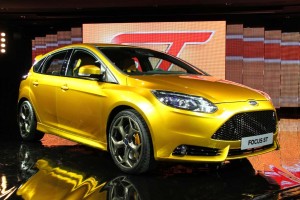
Products like the Ford Focus could pick up share from Japanese makers as the American market recovers, says a new study.
Despite the shortages facing Japanese automakers like Toyota and Nissan, the U.S. new car market appears poised to experience steady sales growth after one of the worst downturns since the Great Depression.
But this rising tide, at least, won’t float all boats equally, cautions research firm A.T. Kearney. It predicts 13.2 million new autos will be sold in the U.S. this year, a roughly 50% increase from the depths of the 2009 downturn. But as many as two points of market share once controlled by the Japanese carmakers could be up for grabs in the next few months – with Detroit and Korean makers in a good position to benefit at the expense of their struggling rivals.
A variety of factors, including fuel prices, could impact the pace of the recovery, while also determining the sort of vehicles American motorists consider, the study indicates. But those who expect a big gain for small car sales could come up short, Kearney analysts warn, pointing to America’s obesity epidemic.
Kearney expects sales of new vehicles to continue increasing over the next two years toward pre-recession levels of about 16 million units by 2013. Since 2007, sales have fallen drastically below anticipated trendlines, which Kearney estimates is equivalent to about 32 million units of pent-up demand.
As the market recovers that could generate at least nine million additional new car sales over the next five to seven years. The study cautions, however, that the availability of financing, total cost of ownership and the unfolding events in Japan will impact vehicle sales in both markets.
The forecast’s wild card is Japan, where in the aftermath of the earthquake and tsunami, parts shortages will reduce 2011 U.S. new vehicle sales by 200,000 units.
“Given what we know about production downtime, in 2011 we see 328,000 U.S. customers of the affected brands up for grabs, and more if the time to wait for a particular brand begins to extend,” said Dan Cheng, A.T. Kearney vice president and the analyst responsible for the firm’s annual automotive study.
Cheng said about half of the consumers, 144,000, are expected to remain loyal to Japanese brands. But the others will consider American and Korean automakers.
Probably two points of market share in the U.S. are now up for grabs as consumers begin to look at new models from American and Korean carmakers.
“Two points of market share is huge,” Cheng said.
The A.T. Kearney study also found when fuel prices increase rapidly, consumers seeking to maintain their total fuel expense as a percentage of their disposable income have a variety of choices beyond simply moving to a smaller vehicle with higher fuel economy. For one thing, they can wait for prices to decline, he said.
Overall, a complicated mix of purchase price, gasoline consumption, finance charges, maintenance and insurance expenses will ultimately factor toward the purchasing decision, with ramifications to the overall demand for new cars, Cheng said.
Safety and comfort are also major concerns for American consumers.
The growing size of overweight Americans is slowing the acceptance of smaller more fuel-efficient cars, says a consultant responsible for an annual survey of the American car business.
“It’s a headwind,” said Cheng. “Gas prices are a tailwind,” he said.
“There is a tight correlation between vehicle size and obesity,” said Cheng, noting the body mass index of the typical American has risen steadily since the mid-1970s.
“We see that as a big drag on the sales of small cars,” said Cheng, noting the sales of vehicles classified as light-duty trucks has risen right along with the number of obese Americans.
The number of obese American is expected to increase by another 18 percent by 2018, said Cheng, who noted the average compact sport-utility vehicle is roughly 20-cubic feet — the equivalent of a standard refrigerator — larger than more efficient small cars.
